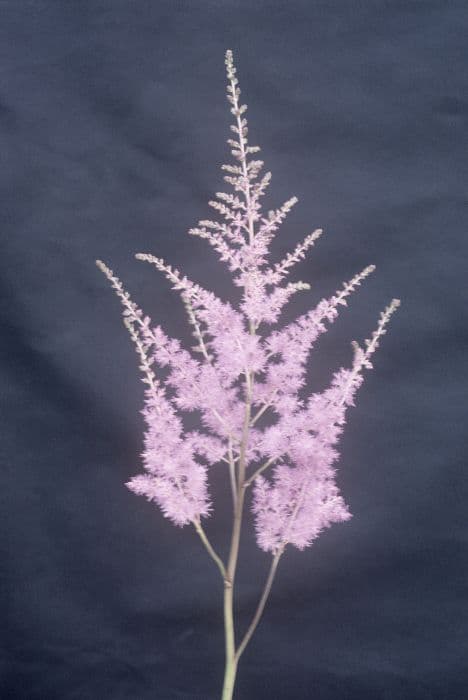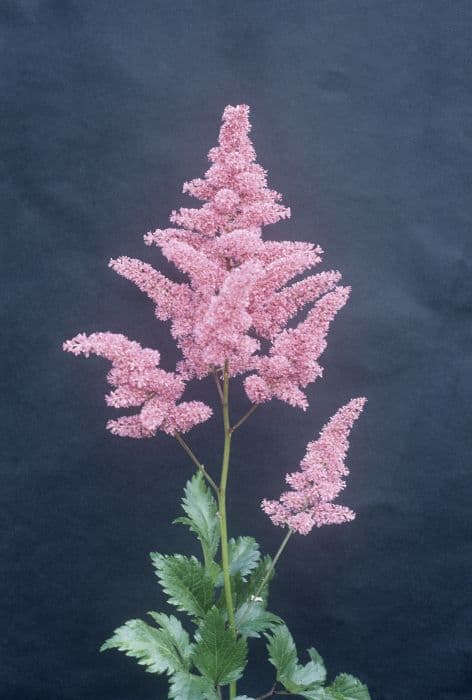False Spirea Astilbe 'Bumalda' (× arendsii)

ABOUT
Astilbe 'Bumalda', commonly known just as Astilbe, is a perennial plant that features distinctive plume-like flowers. The blooms of Astilbe 'Bumalda' are fluffy and feathery, providing a soft, misty look to the flower panicles. These flower clusters typically have a range of colors, often found in shades of pink, and appear on top of stiff stems that rise above the plant's foliage. The leaves of the Astilbe are compound and deeply divided, with a somewhat fern-like appearance. They are often a deep, glossy green, contributing to the plant's lush texture. The foliage forms a mound which serves as a backdrop that contrasts nicely with the delicate flowers floating above. Astilbe 'Bumalda' is known for its hardiness and ability to thrive in shady gardens, where its striking flowers can add a burst of color and texture. As part of a garden border or in a mass planting, these plants create a visually pleasing display with their graceful flower panicles and luxuriant foliage. The overall form of Astilbe 'Bumalda' is clump-forming, giving the plant a full and robust presence in any planting it is a part of.
About this plant
 Names
NamesFamily
Saxifragaceae
Synonyms
False Goat's Beard, False Spirea
Common names
Astilbe × arendsii 'Bumalda'.
 Toxicity
ToxicityTo humans
Astilbe, which includes the variety 'Bumalda', is generally considered non-toxic to humans. There are no well-documented cases of poisoning from consuming or coming into contact with Astilbe, and it is not known to contain any harmful substances that could cause serious illness. However, it is generally advised not to eat ornamental plants due to the potential risk of stomach upset or allergic reactions.
To pets
Astilbe, known commonly just as astilbe, is also generally recognized as non-toxic to pets, including cats and dogs. It does not contain any known toxic compounds and ingestion of this plant is not expected to result in poisoning or serious health issues. As with humans, while not poisonous, non-food plants can sometimes cause mild digestive upset if ingested in significant amounts.
 Characteristics
CharacteristicsLife cycle
Perennials
Foliage type
Deciduous
Color of leaves
Green
Flower color
Pink
Height
2 feet [60 cm]
Spread
2 feet [60 cm]
Plant type
Herb
Hardiness zones
4
Native area
Asia Europe
Benefits
 General Benefits
General Benefits- Attractive Foliage: The Astilbe 'Bumalda' features unique and lush fern-like foliage that provides a textured backdrop in the garden.
- Colorful Blooms: Offers tall, feathery plumes of flowers that come in a variety of colors, adding visual interest to any garden space.
- Shade Tolerance: Thrives in partial to full shade, making it ideal for spots in the garden that receive limited sunlight.
- Low Maintenance: Once established, it requires minimal care beyond regular watering, making it a good option for gardeners of all skill levels.
- Humidity Resistant: Performs well in humid conditions, which can be challenging for many other plants.
- Drought Tolerance: Exhibits a degree of drought tolerance, although it prefers consistently moist soil.
- Good Ground Cover: Its clumping growth habit can help prevent soil erosion and suppress weeds when planted in groups.
- Seasonal Interest: Adds interest to the garden throughout multiple seasons with its changing foliage and blooms.
- Attracts Pollinators: Blooms are attractive to butterflies and other beneficial insects, promoting biodiversity.
- Deer Resistance: Generally resistant to browsing by deer, making it a suitable choice for gardens in deer-prone areas.
 Medical Properties
Medical PropertiesThis plant is not used for medical purposes.
 Air-purifying Qualities
Air-purifying QualitiesThis plant is not specifically known for air purifying qualities.
 Other Uses
Other Uses- Astilbe is often used in dyeing fabric, as the flowers can be boiled to extract natural pigments that impart subtle colors.
- The plant can serve as a natural insect repellent when crushed leaves are spread around outdoor seating areas, due to its fragrance.
- During crafting, dried Astilbe flowers add a delicate touch to homemade paper, providing texture and visual interest.
- In floral photography, Astilbe's feathery plumes can be used to create a soft, romantic backdrop for close-up shots of smaller blooms.
- Astilbe can be used in potpourri mixes to add volume and a soft, feathery texture, enhancing the visual appeal of the mix.
- The flower is sometimes integrated into educational activities, where children can dissect and learn about the parts of a flowering plant.
- Gardeners may use the strong, fibrous stems of Astilbe to create natural supports or trellises for other, more delicate plants.
- The dense foliage of Astilbe can help to prevent soil erosion on slopes or banks, with its roots holding the soil in place.
- Flower arrangers might use Astilbe to create a "floral foam" by tightly packing the stems in a container, which then can hold additional flowers in a precise arrangement.
- In landscape design, Astilbe can be used to create patterns or 'living' artworks by planting different colored varieties in intricate designs.
Interesting Facts
 Feng Shui
Feng ShuiThe Astilbe is not used in Feng Shui practice.
 Zodiac Sign Compitability
Zodiac Sign CompitabilityThe Astilbe is not used in astrology practice.
 Plant Symbolism
Plant Symbolism- Patience: Astilbe takes time to bloom and requires adequate moisture and care, symbolically representing patience and the rewards of waiting.
- Dedication: They need dedicated attention in terms of water and soil conditions, making them a symbol of commitment and dedication in relationships.
- Hope: The bright plumes of Astilbe can symbolize hope and optimism, as they bring color to shady garden areas.
- Prosperity: With its lush foliage and feathery flowers, Astilbe can represent abundance and prosperity.
 Water
WaterFalse Spirea requires consistent moisture, so it's important to water it deeply about once or twice a week, providing about 1 inch of water each time. This equates to approximately 0.623 gallons per square foot. The soil should be kept moist but not soggy, and it's best to water the plant at the base to avoid wetting the foliage, which can lead to fungal diseases. During periods of high heat or drought, you may need to water more frequently to maintain the necessary moisture levels.
 Light
LightFalse Spirea thrives in partial shade to full shade conditions. It performs best when planted in a location that provides morning sun and afternoon shade to protect it from the intense heat of the day. An ideal spot would be one that receives filtered sunlight through tree canopies or dappled light, which helps to mimic the plant's natural woodland habitat.
 Temperature
TemperatureFalse Spirea does well in a wide range of temperatures but prefers cooler conditions. The ideal temperature range for this plant is between 60°F and 75°F. It can withstand periodic dips down to about -30°F once established, but hot temperatures above 85°F may stress the plant. Providing adequate shade and moisture can help mitigate the effects of higher temperatures.
 Pruning
PruningPrune False Spirea to remove spent blooms and encourage a second flowering, as well as to maintain shape and promote vigorous growth. The best time for pruning is immediately after the first blooms fade in late spring or early summer. Cut back the flower stems by about half their length, and consider thinning out any crowded stems to improve air circulation.
 Cleaning
CleaningAs needed
 Soil
SoilFalse Spirea thrives in a soil mix that's rich, moist, and well-draining with a pH range of 6.0 to 8.0. A mix of garden soil, compost, and peat moss with a layer of mulch on top is ideal to retain moisture and provide nutrients.
 Repotting
RepottingFalse Spirea doesn't require frequent repotting; it should be repotted only when it outgrows its current container, typically every 2-3 years, to refresh the soil and accommodate root growth.
 Humidity & Misting
Humidity & MistingFalse Spirea prefers a high humidity environment, thriving in conditions that mimic its natural, damp woodland habitat. Although exact levels are not specified, consistent moisture in the air is beneficial.
 Suitable locations
Suitable locationsIndoor
Place False Spirea in bright, indirect light, and ensure high humidity.
Outdoor
Plant in partial shade, maintain moist soil, and mulch.
Hardiness zone
4-8 USDA
 Life cycle
Life cycleAstilbe 'Bumalda', commonly known as false spirea, begins its life cycle as a dormant rhizome or crown during winter. In early spring, new shoots emerge from the rhizome, and the plant starts to produce compound leaves on sturdy stalks. As the weather warms, the false spirea enters a vigorous growth phase, developing its characteristic feathery plumes of flowers that can be a variety of colors including pink, white, or red, typically blooming in late spring to midsummer. After pollination, which is often aided by insects such as bees and butterflies, the plant produces seeds that can be dispersed by wind or wildlife, completing its reproductive cycle. When the blooming period is over, the plant's foliage continues to provide visual interest before it wilts back with the first frosts of fall. The plant then goes into dormancy again during winter, storing energy in its rhizome for the next growing season.
 Propogation
PropogationPropogation time
Spring-Early Summer
Propogation: The most popular method of propagating Astilbe 'Bumalda' is through division. This is typically done in the spring or fall when the plant is not in active growth. To propagate by division, carefully dig up the plant and use a sharp spade or knife to split the root ball into sections, ensuring that each section has several growing points. These individual divisions can then be replanted immediately into moist, fertile soil, maintaining the same planting depth. Water the new plantings thoroughly to help establish their root systems. This method of propagation allows gardeners to create new plants that are genetically identical to the parent and is especially useful for expanding Astilbe 'Bumalda' in a garden or sharing with fellow gardeners.









